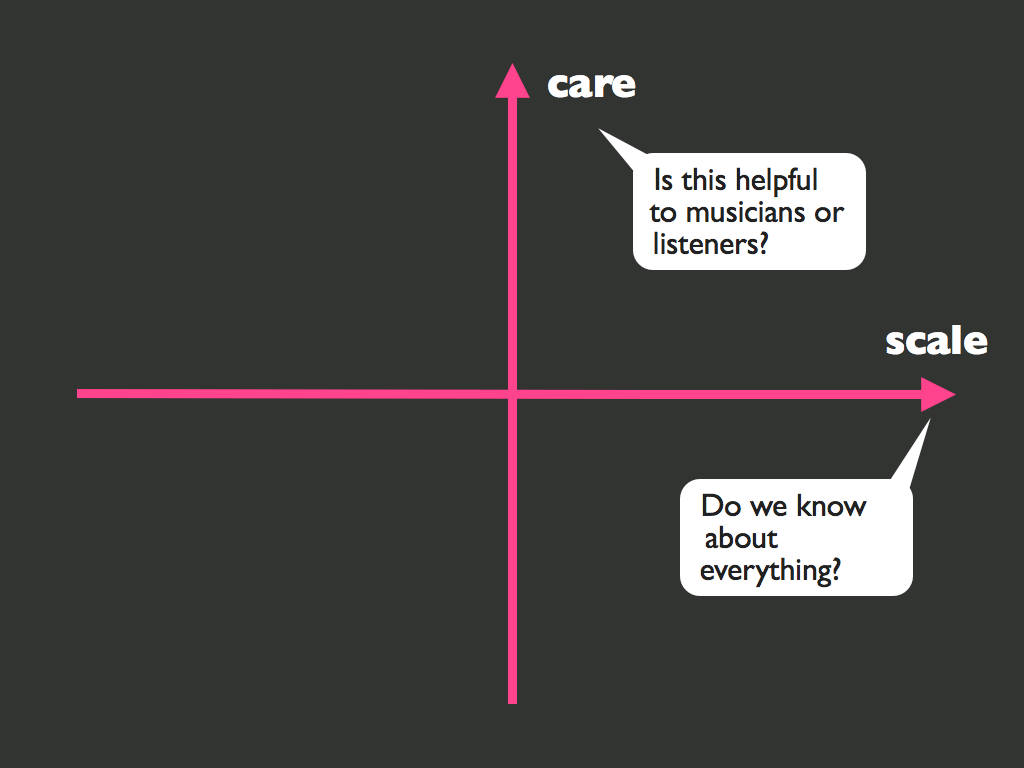Music Curation: Finding Quality When We Get Quantity Over Quality

In an age where music is readily available via streaming music services, how is Spotify using machine learning to find music that is right just for you?
Remember when you heard your new favorite song at a party or on your best friend’s 12-track CD in her car? Before the age of streaming music, there were fewer channels to discover new music, but there was a lot more trust in the content you were consuming. You had a great time at that party or you knew you liked your friends’ tastes in music and were curious to know what they were listening to on their way to school.
Today, companies like Spotify face a changing landscape in music consumption where streaming services have made more music readily available to consumers than ever before. With all the music you could ever dream of act your fingertips, how do you find the latest and greatest songs that you most likely would enjoy?
Many companies have tried to tackle the evergreen problem of curating the perfect content for their consumers. In terms of music curation, it started in the early 2000s like Songza trying to do manual curation where “musical experts” would create playlists with what they thought were the hottest new songs [1]. The shortcoming there was that it did not cater to the individual tastes of each consumer. Pandora took it one step further and enlisted a team of “musicologists” to tag songs with over 450 attributes and customize music to the tastes of individuals in what they called the Music Genome Project [2]. However, it is still a finite list of attributes that are subject to human error and don’t capture all aspects of a listener’s taste in music.
The issue the content distributors face today is in a world where most music is easily accessible, they need to differentiate on the ability to provide the best music listening experience. That experience is primarily driven by finding the right music for each listener. The trade-off to be assessed is with availability of data and scale of analysis, how much care can you offer to your end user [3]. With millions of songs out there, machine learning has become a powerful tool in understand listening habits and predict what individual consumers want most.
Source: How music recommendation works and doesn’t work
To address the issue of finding the right content for its users, Spotify has turned to machine learning and other algorithmic-based models. Most notably, Spotify developed its product called Discover Weekly that curates a playlist of new music every Monday for each user based on their listening habits [4]. Discover Weekly uses three types of recommendation models: collaborative filtering, natural language processing (NLP), and raw audio [5].
The bulk of Spotify’s curation comes from collaborative filtering. Collaborative filtering maps out your likes and dislikes based on your listening habits and then finds other listeners with maps that overlap the most with your map. Then, Spotify will recommend songs these other users have listened to that you have not. In a nutshell, Spotify has recreated your best friend’s CD across millions of new friends that you didn’t know existed.
The second piece, NLP, quite literally processes the spoken words in songs. Spotify analyzes each term and places a weight on it to understand the relative importance of that word to the song or artist. Now, instead of creating a map of the user, Spotify is creating a map of the song. Then, similarly to collaborative filtering, it will match up the maps of different songs to find the most overlap [6].
The last input into the Discover Weekly product is the raw audio model. While the first two models focus on matching active users and frequently heard songs, raw audio models allow Spotify to analyze new songs with less data. By utilizing convolutional neural networks, Spotify is able to process fragmented time-series of songs and characterize songs on time signature, key, mode, tempo, and loudness [7].
Discover Weekly has been successful in the short-term at using machine learning to improve the care and scale of curating music recommendations for its users. Despite all of this, I still believe listening to music is a deeply personal experience that users associate with a time, place, or feeling that no amount of data can replace. Spotify needs to continue innovating on how to deliver a personal music listening experience. After all, it is still the user deciding whether they want to take the recommendation, and if a friend tells me to listen to a song, I am more likely to listen to it than if Spotify put it in an auto-generated playlist.
Looking forward, I think there are two key questions that streaming music providers face:
- How can you use machine learning and big data analytics to further scale the curation of content for its users?
- How do you make machine-generated curated playlists as trustworthy as your friends other personal sources?
[Word Count: 800]
[1] https://www.pandora.com/about/mgp
[2] https://medium.com/s/story/spotifys-discover-weekly-how-machine-learning-finds-your-new-music-19a41ab76efe
[3] https://notes.variogr.am/2012/12/11/how-music-recommendation-works-and-doesnt-work/
[4] https://www.spotify.com/us/discoverweekly/
[5] https://medium.com/s/story/spotifys-discover-weekly-how-machine-learning-finds-your-new-music-19a41ab76efe
[6] https://medium.com/s/story/spotifys-discover-weekly-how-machine-learning-finds-your-new-music-19a41ab76efe
[7] https://medium.com/s/story/spotifys-discover-weekly-how-machine-learning-finds-your-new-music-19a41ab76efe




I completely agree that listening to and discovering music is still a deeply personal experience. To address your second question, I wonder if Spotify would benefit by enhancing the social features of its platform. I am not a Spotify user myself, but I could imagine that they could try to replicate the social aspect of discovering music by linking your Spotify profile to your Facebook profile, and sending recommendations of songs to your friends via a messaging platform within the app. Alternatively, you could see what your “friends” are listening to at any given moment. Perhaps some of these features exist to a degree, but I do think there is a bit of “magic” to making the experience more human and personal.
Really interesting. I’m a big Spotify fan and user myself, and just to answer one of S.P.’s comments above – you can follow your friends on Spotify and see what they are listening to at anytime. It feels more creepy and invasive that anything, because music IS so personal. And we all know that what we play with our friends in the car is definitely different than what we listen to at home alone in our rooms!
Just to comment on your second question – I agree, I’m not sure a machine learning algorithm could ever replace that secret sauce that makes us love a certain song or band. I feel like we will only get closer to that answer once we have computer chips in our brains, Black Mirror style.
Interesting topic! I am overall skeptical about whether machine learning can find me my song list, because according to what you say, it predicts my tastes by analyzing my past listening behavior, such as the using NLP to analyze lyrics or finding an user with similar tastes to me. But I think personal tastes evolve with time – I want to hear something totally different today than I did yesterday, because each moment I am in different mood. Unless machine learning can read my mind and uncover the tiny emotions that I myself can not describe accurately, I don’t think it can craft a perfect song list for me.